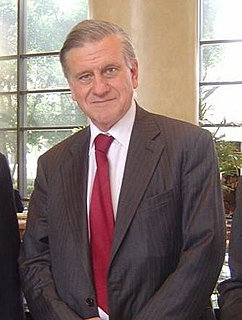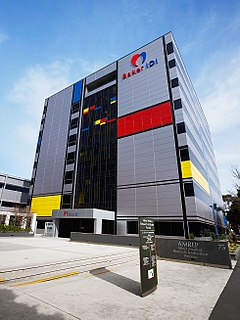Related Research Articles

Coronary artery disease (CAD), also called coronary heart disease (CHD), ischemic heart disease (IHD), myocardial ischemia, or simply heart disease, involves the reduction of blood flow to the heart muscle due to build-up of plaque (atherosclerosis) in the arteries of the heart. It is the most common of the cardiovascular diseases. Types include stable angina, unstable angina, myocardial infarction, and sudden cardiac death. A common symptom is chest pain or discomfort which may travel into the shoulder, arm, back, neck, or jaw. Occasionally it may feel like heartburn. Usually symptoms occur with exercise or emotional stress, last less than a few minutes, and improve with rest. Shortness of breath may also occur and sometimes no symptoms are present. In many cases, the first sign is a heart attack. Other complications include heart failure or an abnormal heartbeat.
High-density lipoprotein (HDL) is one of the five major groups of lipoproteins. Lipoproteins are complex particles composed of multiple proteins which transport all fat molecules (lipids) around the body within the water outside cells. They are typically composed of 80–100 proteins per particle and transporting up to hundreds of fat molecules per particle.

Low-density lipoprotein (LDL) is one of the five major groups of lipoprotein which transport all fat molecules around the body in the extracellular water. These groups, from least dense to most dense, are chylomicrons, very low-density lipoprotein (VLDL), intermediate-density lipoprotein (IDL), low-density lipoprotein (LDL) and high-density lipoprotein (HDL). LDL delivers fat molecules to cells. LDL is involved in atherosclerosis, a process in which it is oxidized within the walls of arteries.

Atherosclerosis is a pattern of the disease arteriosclerosis in which the wall of the artery develops abnormalities, called lesions. These lesions may lead to narrowing due to the buildup of atheromatous plaque. At onset there are usually no symptoms, but if they develop, symptoms generally begin around middle age. When severe, it can result in coronary artery disease, stroke, peripheral artery disease, or kidney problems, depending on which arteries are affected.

Statins, also known as HMG-CoA reductase inhibitors, are a class of lipid-lowering medications that reduce illness and mortality in those who are at high risk of cardiovascular disease. They are the most common cholesterol-lowering drugs.

An atheroma, or atheromatous plaque, is an abnormal and reversible accumulation of material in the inner layer of an arterial wall.

Paul M. Ridker is a cardiovascular epidemiologist and biomedical researcher. He is currently the Eugene Braunwald Professor of Medicine at Harvard University and Brigham and Women's Hospital, where he directs the Center for Cardiovascular Disease Prevention. Ridker also holds an appointment as Professor in the Department of Epidemiology at the Harvard T.H. Chan School of Public Health.

Intima–media thickness (IMT), also called intimal medial thickness, is a measurement of the thickness of tunica intima and tunica media, the innermost two layers of the wall of an artery. The measurement is usually made by external ultrasound and occasionally by internal, invasive ultrasound catheters. Measurements of the total wall thickness of blood vessels can also be done using other imaging modalities.

Prediabetes is a component of the metabolic syndrome and is characterized by elevated blood sugar levels that fall below the threshold to diagnose diabetes mellitus. It usually does not cause symptoms but people with prediabetes often have obesity, dyslipidemia with high triglycerides and/or low HDL cholesterol, and hypertension. It is also associated with increased risk for cardiovascular disease (CVD). Prediabetes is more accurately considered an early stage of diabetes as health complications associated with type 2 diabetes often occur before the diagnosis of diabetes.

The Libin Cardiovascular Institute is a partnership between Alberta Health Services and the University of Calgary. Its mandate comprises all cardiovascular research, education and service delivery, with a service area extending from Saskatchewan, Southern Alberta and Eastern British Columbia. The Institute coordinates the activities of over 1,500 individuals in Southern Alberta. Of its more than 175 research and clinician members, over 75 are cardiologists, making it the largest heart or cardiovascular institute in Western Canada by that measure.

Valentín Fuster Carulla, 1st Marquess of Fuster is a Spanish cardiologist and aristocrat.

The Baker Heart and Diabetes Institute, commonly known as the Baker Institute, is an Australian independent medical research institute headquartered in Melbourne, Victoria. Established in 1926, the institute is one of Australia's oldest medical research organisations with a historical focus on cardiovascular disease. In 2008, it became the country's first medical research institute to target diabetes, heart disease, obesity and their complications at the basic, clinical and population health levels.
John David Spence is a Canadian medical doctor, medical researcher and professor at the University of Western Ontario. Along with his affiliation with the University of Western Ontario he is affiliated with the London Health Sciences Centre's University Hospital and the Robarts Research Institute, one of Canada's leading medical research organizations. He is a recognized expert in stroke prevention and stroke prevention research and has over 500 peer-reviewed publications since 1970. He has delivered more than 600 lectures in 38 countries to physicians around the world. In 2015, he received the Research Excellence Award from the Canadian Society for Atherosclerosis, Thrombosis and Vascular Biology. In 2019, he was appointed a Member of the Order of Canada.

Russell Ross (1929–1999) was an American professor of pathology, known for research on the pathogenesis of atherosclerosis.
The Multi-Ethnic Study of Atherosclerosis is an ongoing medical study which aims to investigate the characteristics of subclinical atherosclerosis and other cardiovascular diseases, and to determine risk factors for its progression to the clinically overt form of these diseases. Sponsored by the National Heart, Lung and Blood Institute, MESA was begun in July 2000, and it follows a population-based sample of 6,814 American men and women aged 45 to 84, recruited from six field centers. The diverse sample consists of 38% White subjects, 28% African American, 22% Hispanic, and 12% Asian. Over 1,000 peer-reviewed papers have been published based on MESA and its 145 independent ancillary studies.
Amy Lynn Doneen is an American doctor of nursing practice (DNP) and co-founder of the BaleDoneen Method for the prevention and treatment of heart attack, stroke and type 2 diabetes, and for treatment after one of these medical events.
Retinal vessel analysis is a non-invasive method to examine the small arteries and veins in the retina which allows to draw conclusions about the morphology and the function of small vessels elsewhere in the human body. Retinal vessel analysis is conducted mainly by ophthalmologists, cardiologists, neurologists and other medical specialities dealing with vascular diseases.

Guadalupe Sabio Buzo is a Spanish scientist and Professor at the Spanish National Cardiovascular Research Centre, which is part of the Carlos III Health Institute. Her research considers stress-activated kinases and the development of diseases associated with obesity. She was awarded the Princess of Girona Foundation Scientist Prize in 2012 and selected as one of the Top 100 Women Leaders in Spain in 2017.
Dr. Robert S. Rosenson is a Professor of Medicine and also lending his services as the Director of cardio metabolic disorders at the Icahn School of Medicine at Mount Sinai.

John A. Ambrose is an internationally renowned expert in coronary artery disease. He is one of the pioneers in acute coronary syndromes having published over 40 articles in the cardiology literature between 1985 and 2000 on their pathogenesis. He has also published extensively on cigarette smoking and cardiovascular disease. Working with his PhD candidate, Rajat Barua, utilizing a novel in vitro model, they described the effects of cigarette smoking on nitric oxide biosynthesis, endothelial function, and endothelial-derived fibrinolytic and antithrombotic factors. Their 2004 update on cigarette smoking and cardiovascular disease published in the Journal of the American College of Cardiology has been referenced over 2,100 times as of 2020. Ambrose is currently a Professor of Clinical Medicine at the University of California, San Francisco. He was also a Director of the Cardiac Catheterization Laboratory at Mount Sinai Hospital and received a National Leadership Award from the National Republican Congressional Committee.
References
- ↑ Fuster, Valentín (2007). "Centres of excellence: a Spanish cardiovascular research initiative. Interview by Jennifer Taylor". Circulation . 115 (21): f104–6. doi: 10.1161/circulationaha.107.184354 . PMID 17536248.
- ↑ Fuster, Valentín; Torres, Miguel (2012). "CNIC: Achieving Research Excellence Through Collaboration". Rev Esp Cardiol (Engl Ed). 65 (6): 511–6. doi:10.1016/j.recesp.2012.01.008. PMID 22555314.
- ↑ Progression of Early Subclinical Atherosclerosis - Full Text View - ClinicalTrials.gov , retrieved 2019-09-28